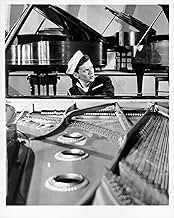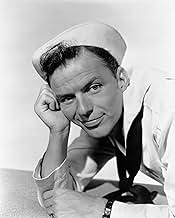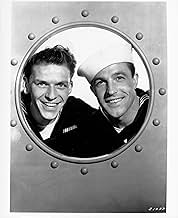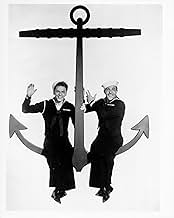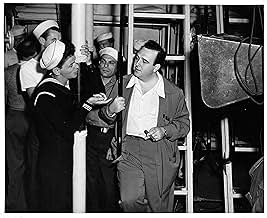IMDb RATING
7.0/10
9.8K
YOUR RATING
A pair of sailors on leave try to help a movie extra become a singing star.A pair of sailors on leave try to help a movie extra become a singing star.A pair of sailors on leave try to help a movie extra become a singing star.
- Directors
- Writers
- Stars
- Won 1 Oscar
- 5 wins & 4 nominations total
Rags Ragland
- Police Sergeant
- (as 'Rags' Ragland)
Carlos Ramírez
- Carlos
- (as Carlos Ramirez)
- Directors
- Writers
- All cast & crew
- Production, box office & more at IMDbPro
Summary
Reviewers say 'Anchors Aweigh' is a classic MGM musical with Gene Kelly, Frank Sinatra, and Kathryn Grayson. It features memorable dance sequences, vibrant Technicolor, and innovative camera work. Themes of love, friendship, and ambition are explored. Songs by Jule Styne and Sammy Cahn enhance the charm. Despite some criticisms of length and pacing, the film is celebrated for its entertainment value and historical significance.
Featured reviews
What surprises me here is how good Sinatra is. He's certainly playing against his later cock-sure image. No king of the walk here. Instead his Clarence (note the name) is likable but chock-full of self-doubt. And he's very good at being shy, retiring, and charming in a boyish way. It's a Sinatra as I've never seen him. On the other hand, there's the boldly self-assured Joe (Kelly) who dominates, as the two sailors try to get a big-time audition for the winsome Susan (Grayson). Somehow, however, they can't reach big-time impresario Jose Iturbi. But they and we have a good time trying.
Along the way, Kelly gets his legendary dance with cartoon mouse Jerry of Tom & Jerry, looking like it came right out of the Land of Oz. Then too, I like his really charming number with the little Mexican girl (McManus). Overall, however, it's the elaborate sets, glossy Technicolor, and sparkling personalities that shine. Frankly, I thought the musical selections were entertaining but nothing memorable. Also the storyline meanders a bit too much, particularly near the end. Note too how classical numbers are worked into the selections, quite typical for that time. I guess producers wanted to broaden the musical appeal, and lend a touch of 'class'.
All in all, the movie's MGM at it's glossy best. And though a bit overlong, the results still fit the classic bill, along with the perfect pairing of the two male leads.
Along the way, Kelly gets his legendary dance with cartoon mouse Jerry of Tom & Jerry, looking like it came right out of the Land of Oz. Then too, I like his really charming number with the little Mexican girl (McManus). Overall, however, it's the elaborate sets, glossy Technicolor, and sparkling personalities that shine. Frankly, I thought the musical selections were entertaining but nothing memorable. Also the storyline meanders a bit too much, particularly near the end. Note too how classical numbers are worked into the selections, quite typical for that time. I guess producers wanted to broaden the musical appeal, and lend a touch of 'class'.
All in all, the movie's MGM at it's glossy best. And though a bit overlong, the results still fit the classic bill, along with the perfect pairing of the two male leads.
Overall this is a delightful, light-hearted, romantic, musical comedy. I suppose a small case could be made for the movie being to long. But I'm not sure what you would cut out. The singing that Kelly and Sinatra do? No. The fabulous dancing that Kelly does? No. The time the movie takes to develop the story line and develop the relationships of the characters? No (that seems to be a common complaint many times that more recent movies don't develop the characters).
Some comment that Iturbi didn't bring much to the movie but this gives us a chance to see and hear a great talent from the 1040s. So what if he wasn't an actor? He was an important part of the movie as the basic plot was to get Grayson an audition with him.
Originally Katherine Grayson wanted to be an opera star. Louis B. Mayer brought her to MGM for a screen test that included an aria. During her audition in the movie there is a shot of the MGM brass nodding and smiling. You can just imagine it was like that when she had made her real screen test years before.
This movie is so full of life it is hard to hit all of the highlights. Great use was made of color and lighting throughout the movie. You can see why Frank Sinatra became the star he did. A nice counter-point in the movie is how Sinatra (a ladies man even then) played the role of wanting to just find a date while on leave. You'll feel good after seeing this movie. 7/10
Some comment that Iturbi didn't bring much to the movie but this gives us a chance to see and hear a great talent from the 1040s. So what if he wasn't an actor? He was an important part of the movie as the basic plot was to get Grayson an audition with him.
Originally Katherine Grayson wanted to be an opera star. Louis B. Mayer brought her to MGM for a screen test that included an aria. During her audition in the movie there is a shot of the MGM brass nodding and smiling. You can just imagine it was like that when she had made her real screen test years before.
This movie is so full of life it is hard to hit all of the highlights. Great use was made of color and lighting throughout the movie. You can see why Frank Sinatra became the star he did. A nice counter-point in the movie is how Sinatra (a ladies man even then) played the role of wanting to just find a date while on leave. You'll feel good after seeing this movie. 7/10
Famous for the scene where Gene Kelly dances a duet with Jerry Mouse, this zippy musical is also the one where Kathryn Grayson trills 'Jealousy', and Frank Sinatra sings in the arena of a thousand pianos ('I Fall in Love Too Easily'). Grayson is a young mother who wants more than anything else to be in the movies. Her little boy (Dean Stockwell, who would turn up much later in TV's Quantum Leap) wants to join the US forces, and so he meets sailors Kelly and Sinatra heading out for a bit of leave. There are some echoes of 'On the Town' in this movie, but not enough to spoil the mix.
I love these old musicals where they seemed to throw in everyone under contract with the studio. I love the classical music, with Iturbi's very old school highly arched fingers doing amazing things on the keyboard while he also conducted. I love bringing in the next generation of performers. I love the silliness. I love Gene Kelly giving the studio insurance agents palpitations in the bandit scene and calling Kathryn Grayson "Aunt Susie." I love the whole wonderful mishmash. There's something for everyone and if it runs long, well, you can pick which musical number to miss for your bathroom break. :) I wish all the songs were credited at the end but that wasn't the custom then. This has one of my two favorite on screen renditions of the Hungarian Rhapsody. The other was done by Bugs Bunny being bedeviled by a mouse. These musicals are time capsules of great talents, fashions, musical tastes, and movie techniques. I've seen this many times and I hope to see it many more.
MGM was intent on making the most of its hot new properties Kelly and Sinatra in this affable sailor saga. The stars' characters were created with maximum screen impact in mind, and were to be retained (with minor adjustments) in "Take Me Out To The Ball Game" and "On The Town". Gene Kelly plays Joe "Sea Wolf" Brady, the twinkle-eyed Irish womaniser who never quite seems to get a woman. Clarence "Brooklyn" Doolittle, Sinatra's screen persona, was put together as a blatant attempt to pander to his bobbysoxer following. He is the bashful, slightly geeky ingenu, pushing his cuteness for all it's worth - "the romantical type fella".
"Anchors Aweigh" set the pattern for a whole assembly line of MGM musicals to come, and one could almost say it established an art-form. Kelly did the choreography, and his first-ever 'dream ballets', two of them, are on display here - the famous pas de deux with Jerry The Mouse, and the Zorro interlude. The dance sequences are brimming with innovative ideas - mixing human action with animation, artistic use of slow motion, 'playing' the items on the craft stall and bouncing on the beds in the servicemen's hostel.
MGM itself appears, almost as a character in the movie, with self-indulgent shots of the art deco facade and the bustle of the back lot. Jose Iturbi, the Spanish musical director contracted to MGM at the time, plays himself in a slightly odd role. He is the big noise at the studio whom Aunt Susie is anxious to impress, and in a bid to give the meandering storyline some cohesion, he opens the film conducting the Navy band (this strange set-up is 'explained' in a later throwaway line: he was brought in to tighten-up the Navy's musical style). There are two problems with giving Iturbi an important role in the movie - one, nobody has ever heard of Jose Iturbi, and two, his Valencian accent is so strong that it renders him virtually unintelligible. But anyhow, Iturbi conducts the said Navy band, and then an orchestra on the MGM sound stage, playing a "Rhapsody In Blue" rip-off. He presides over Aunt Susie's auditon, and plays some classical stuff at the keyboard (including an interesting "Hungarian Rhapsody" at the Hollywood Bowl, with massed pianos).
The plot (if that is not too choate a term for it) goes thus: an aircraft carrier puts in at San Diego, and two sailors are given shore leave. They encounter a little boy who leads them to his pretty Aunt Susie, a taco joint chanteuse who dreams of the big time. Without giving the game away, I can reveal that more than one person falls in love Susie, leading to the customary complications and misunderstandings. The energy and exuberance of the performances, and particularly that of Kelly, carry the madcap action along nicely, and the eccentricities of a storyline which goes from mariachi groups to Tom And Jerry don't seem so very outlandish after all. This new brand of musical comedy, breaking completely with the pre-war conventions of tuxedos and ocean liners, is attractive and refreshing.
Young Mister Sinatra, under a separate contract from the others, sings numbers specially written for him by Jules Styne and Sammy Cahn. By far the best of these formulaic boy-crooner ballads is the final one, "I Fall In Love Too Easily". Throughout the film, Frank sings in his upper register, aiming for a light ballad sound, and consequently not doing any justice to that reedy baritone voice.
The film has attractive visual gimmicks, quite apart from the man-and-cartoon-mouse stuff. Iturbi plays a transparent keyboard, shot from below. In a clever comment on the storyline, Joe rises from the table and physically comes between Clarence and Susie. The string section of the orchestra is filmed playing pizzicato in the reflection of Iturbi's grand piano.
Katherine Grayson is more than adequate playing the female ingenue, and her voice is spectacular, if a little too showy and operatic. The screen test is a knockout coloratura performance.
The film falls away a little towards the end. The Hollywood Bowl is incorporated, one feels, merely to give the movie a photogenic location to use, and this passage distorts the storyline somewhat. The fallings in and out of love are totally arbitrary, and the resolutions hurried and thin. But for all that, "Anchors Aweigh" is fun to watch, and its stylistic innovations paved the way for the great MGM musicals of the next ten years.
"Anchors Aweigh" set the pattern for a whole assembly line of MGM musicals to come, and one could almost say it established an art-form. Kelly did the choreography, and his first-ever 'dream ballets', two of them, are on display here - the famous pas de deux with Jerry The Mouse, and the Zorro interlude. The dance sequences are brimming with innovative ideas - mixing human action with animation, artistic use of slow motion, 'playing' the items on the craft stall and bouncing on the beds in the servicemen's hostel.
MGM itself appears, almost as a character in the movie, with self-indulgent shots of the art deco facade and the bustle of the back lot. Jose Iturbi, the Spanish musical director contracted to MGM at the time, plays himself in a slightly odd role. He is the big noise at the studio whom Aunt Susie is anxious to impress, and in a bid to give the meandering storyline some cohesion, he opens the film conducting the Navy band (this strange set-up is 'explained' in a later throwaway line: he was brought in to tighten-up the Navy's musical style). There are two problems with giving Iturbi an important role in the movie - one, nobody has ever heard of Jose Iturbi, and two, his Valencian accent is so strong that it renders him virtually unintelligible. But anyhow, Iturbi conducts the said Navy band, and then an orchestra on the MGM sound stage, playing a "Rhapsody In Blue" rip-off. He presides over Aunt Susie's auditon, and plays some classical stuff at the keyboard (including an interesting "Hungarian Rhapsody" at the Hollywood Bowl, with massed pianos).
The plot (if that is not too choate a term for it) goes thus: an aircraft carrier puts in at San Diego, and two sailors are given shore leave. They encounter a little boy who leads them to his pretty Aunt Susie, a taco joint chanteuse who dreams of the big time. Without giving the game away, I can reveal that more than one person falls in love Susie, leading to the customary complications and misunderstandings. The energy and exuberance of the performances, and particularly that of Kelly, carry the madcap action along nicely, and the eccentricities of a storyline which goes from mariachi groups to Tom And Jerry don't seem so very outlandish after all. This new brand of musical comedy, breaking completely with the pre-war conventions of tuxedos and ocean liners, is attractive and refreshing.
Young Mister Sinatra, under a separate contract from the others, sings numbers specially written for him by Jules Styne and Sammy Cahn. By far the best of these formulaic boy-crooner ballads is the final one, "I Fall In Love Too Easily". Throughout the film, Frank sings in his upper register, aiming for a light ballad sound, and consequently not doing any justice to that reedy baritone voice.
The film has attractive visual gimmicks, quite apart from the man-and-cartoon-mouse stuff. Iturbi plays a transparent keyboard, shot from below. In a clever comment on the storyline, Joe rises from the table and physically comes between Clarence and Susie. The string section of the orchestra is filmed playing pizzicato in the reflection of Iturbi's grand piano.
Katherine Grayson is more than adequate playing the female ingenue, and her voice is spectacular, if a little too showy and operatic. The screen test is a knockout coloratura performance.
The film falls away a little towards the end. The Hollywood Bowl is incorporated, one feels, merely to give the movie a photogenic location to use, and this passage distorts the storyline somewhat. The fallings in and out of love are totally arbitrary, and the resolutions hurried and thin. But for all that, "Anchors Aweigh" is fun to watch, and its stylistic innovations paved the way for the great MGM musicals of the next ten years.
Did you know
- TriviaWhen the dance sequence with Gene Kelly and Jerry Mouse was screened for MGM executives, someone noticed that, although Gene Kelly's reflection shone on the floor during his dancing, Jerry's did not. This required animators William Hanna, Joseph Barbera, and their team to go back and draw Jerry's reflection on the floor as he was dancing.
- GoofsWhen Clarence is singing to the waitress in the restaurant, there is a picture of Susita on the wall. When seen at a distance, her head is tilted to the left, but in a closeup, her head is vertical.
- Quotes
Jerry Mouse: Look at me, I'm dancing.
- Crazy credits[in some versions, after the end credits]
TO FAMILIES AND FRIENDS OF SERVICEMEN AND WOMEN:
Pictures exhibited in this theatre are given to the armed forces for showing in combat areas around the world.
WAR ACTIVITIES COMMITTEE MOTION PICTURE INDUSTRY
- ConnectionsEdited into American Masters: Gene Kelly: Anatomy of a Dancer (2002)
- SoundtracksAnchors Aweigh
(1906) (uncredited)
Music by Charles A. Zimmerman
Played off-screen during the opening credits
Played by a Navy Band conducted by José Iturbi
- How long is Anchors Aweigh?Powered by Alexa
Details
Box office
- Gross worldwide
- $2,556
- Runtime
- 2h 20m(140 min)
- Aspect ratio
- 1.37 : 1
Contribute to this page
Suggest an edit or add missing content



